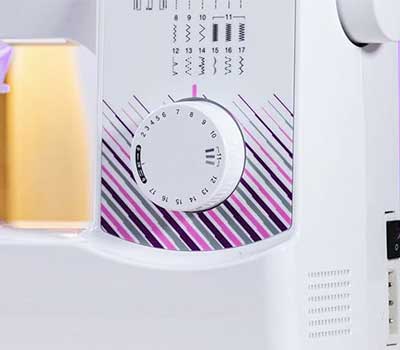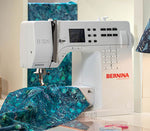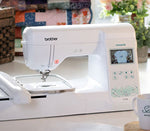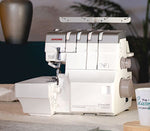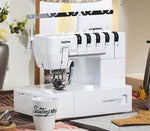Updated: 21st March 2024.
Author: Darius Navai
Sewing Machine Buyers Guide
What Sewing Machine Should I Buy?
Our guide to sewing machines below inform you how to know what sewing machine to buy. We'll discuss what to consider when buying a sewing machine and how to match those features to the projects you want to make.
Once you have read this informative guide, you'll know what is a good sewing machine to buy.
Embroidery Buyers Guide
Discover the options, features and benefits of embroidery machines
Overlockers Buyers Guide
Discover the options, features and benefits of embroidery machines
What to consider when buying a sewing machine?. Here are our Top 3 tips for sewing machine shopping:
- Think long term. A good domestic sewing machine should give years of good service. Think about what you want now, and the next 10 years. Make the right decision first time not second!
- Buy cheap, Buy twice: DON'T be tempted by the price tag or claims the sellers make, if the largest sewing machine manufactures in the world like Janome or Brother can't make a reliable sewing machine to retail for less than £99 then it cannot be done.
- Buy the right tool for the job: Don't expect a cheap light weight sewing machine to sew up your heavy weight curtains trouble free, it just won't happen wherever you buy it from. It has to be 'fit for purpose'. The machine can have all the features and functions you need but if it is not capable of sewing your denim jeans or curtain header tape you will want to throw it through the window! The sturdier the machine is, the better.
Next, consider the fabric you will be sewing with...
Things to consider before buying a sewing machine:
1. Sewing Machine Size
When deciding which sewing machine to purchase, you’re going to want to make sure that the size of the machine is what you want and need. Machines come in a few different sizes, and size can determine the types of projects you work on as well as where you can keep it in your home.
Machine Sizes...
2. Sewing Machine Workspace Size
The amount of workspace available on the sewing machine itself will determine what kinds of projects you’ll be able to work on. Most sewists won’t need a huge amount of space on the machine - However, preference should also be taken into consideration. Workspace includes both the throat space and if there is an extension table included.
Workspace Sizes...
3. Sewing Machine Weight
The weight of your new sewing machine can be important. If you can’t lift more than a certain amount of weight then you want to make sure you’re getting a model that’s within that range. You may need to consider if you’re going to be travelling, for example to a local sewing class, then you want to make sure that it's light enough to carry easily.
Machine Weights...
4: Sewing Machine Control type
Sewing machines come with three main control types: mechanical, computerised, and touchscreen. This is all about preference in how you control your sewing machine and select stitches.
5. Sewing Machine Price
The price of the sewing machine you purchase will be a big indicator of the quality of the machine. It will tell you how high of quality materials were used to build the machine and how many features are included with the machine as well.
6. Condition: Brand new or ex-display sewing machine?
When you’re looking into purchasing a new-to-you machine, you want to be sure that you’re getting a quality machine.
7. Sewing Machine Covers and Cases
What kind of case comes with your machine is important. If you have plans to travel or you plan to leave your machine out on your sewing table, a cover is essential to protect it from dust and any bumps or bangs.
Hard Covers
Hard covers are great for machines that will be stored in places that might damage the machine (such as in a closet or under the bed), or if you plan to travel with the machine. Hard cases are great for protecting the machine against both dust and physical damage over time.
Dust Covers
It might seem backwards that some of the more expensive machines come with dust covers instead of hard covers, but that’s because they’re meant to stay in one place. Dust covers do a better job protecting the sewing machine from dust than a hard cover as they don’t have as many holes for the handles of the sewing machine to carry the machine while covered, which is important in keeping your machine in great working order.
8. Sewing Machine Accessory Compartments
Where you store your machine’s accessories is important to consider. Some machines come with elaborate compartments with specific spots for each presser foot, others come with no place to store your accessories. It’s rare to find a sewing machine with no accessories compartment, but they are out there. These machines generally won’t have too many accessories and are typically straight-stitch-only machines, so you won’t be able to use other presser feet anyway.
9. Front vs Top Loading Bobbin: What is the difference?
How you load a bobbin can make all the difference in your sewing experience. Some people tend to prefer front-loading bobbins, which are found on many older machines like Singer Featherweights. They’re tried and true, but they come with their own faults. Others prefer the newer top-loading bobbins for their ease.
Front-Loading Bobbin
Front-loading bobbins have been around since the 19th century. They can be difficult to load- they can be hard to see unless you bend over at an odd angle, and they’ve been known to jam more often. If your machine is in tip-top shape, you shouldn’t have difficulties. However, there are benefits to a good front-loading bobbin, especially if you’re looking for a sewing and embroidery machine as you won’t have to unload your embroidery project every time you have to change out the bobbin. You’ll find this bobbin style on Bernina machines in particular.
Top-Loading Bobbin
Top-loading bobbins are much easier to load and clean. They’re also called drop-in bobbins because you simply drop it into the machine and wrap the thread where the arrows point and you’re ready to sew! And to clean, which helps you to avoid jams, you can pop off the needle plate to brush out the lint and dust that’s been collecting. This bobbin style is used by Janome, Brother, and many other brands on their computerised machines, especially.
Easy Set Bobbin
Easy set bobbins, or quick set bobbins, are a type of top-loading bobbins. They’re able to drop in the bobbin and pull the thread through quickly so that you can take off sewing much quicker than other machines.
10. Sewing Machine Motor Type
The type of motor in your sewing machine will determine how powerful the sewing machine is. This affects speed and durability.
11. Adjustable or Non-adjustable Foot Pressure
Being able to adjust your presser foot pressure is a feature that’s usually found on higher-end models of sewing machines. It’s meant to help you sew different types of fabrics and feed them through the machine easier so that nothing gets stuck, ripped, or bunched.
12. Types of Stitches
When you’re working with knits and other stretchy fabrics, you want to make sure that you’re using the appropriate stitches. When you’re working with fabrics that need to be able to stretch, you need to be using stitches that will allow it. A normal straight stitch won’t do that, in fact it might cause tearing over time.
Luckily, most machines, both mechanical and computerised, will come with at least one or two stitches that are meant for stretchy fabrics.
13. Separate Sewing Width & Length Controls
Needing to control and customise your stitches by length and width can really change your sewing experience. For more advanced sewers, they’ll be able to customise their stitches to suit specific projects!
Singular
Separate
Buttons
No Separate Controls
Sewing machines with limited stitches might not allow you to customise those stitches. They’re built in with very specific settings and you can’t change them. This is ok for people who either only need a straight stitch, or you’re just starting out on your sewing adventure.
Separate Controls - Dials
Mechanical sewing machines may allow you to change the stitch width and length using a separate dial on the machine. Some computerised machines will also use a dial for lower-priced and quality machines. Dials might be harder to make sure your stitches are uniform if you’re guessing where your dial was the last time you turned your machine on.
Separate Controls - Buttons
Computerised machines will typically have buttons to select stitch length and width sizes. Buttons can be easier to use for some, and it’s all about preference. These controls are more precise, and you can make sure that if you turn off your machine mid-project, you can get the same measurements when you come back to it!
14. 1-step or 4-step Buttonholes?
If you’re a dressmaker, you’ll want to be sure that the sewing machine you purchase has all of the buttonhole stitches that you need, and you want to make sure they’re easy to stitch. Mechanical sewing machines tend to have limited buttonholes that can take a few steps to create, while computerized machines may have upwards of ten different buttonholes programmed in to choose from.
15. Type of Feed Dog in a Sewing Machine
How fabric will feed through your sewing machine should be considered when you’re making the decision on what kind of sewing machine to purchase. Different feed systems allow for more precise stitching and feeding, and can even allow you to work on different types of fabric.
16. Flat Bed vs Free Arm Sewing Machine
How your machine’s bed is built will tell you what types of projects you can use the machine for. Most machines come with both a flat bed and a free arm and are easily convertible. But there are machines out there that only offer a flat bed, and you should make sure that if you’re looking for a machine with a free arm that you’re getting exactly what you need.
Flat Bed Sewing Machine
Machines with only a flat bed are few and far between, but they are out there. They come in all sizes and price points. They’re great for quilters who don’t need to use the free arm for smaller, circular projects or have an immediate want for an extension table. You can get extension tables custom made for these machines, but you might be paying extra.
Free Arm Sewing Machine
If you’re sewing garments, you’re going to need a free arm. The free arm allows you to sew cuffs on shirts and pants with ease! And most extension tables are built with the free arm in mind so that your sewing space is sturdier and more seamless.
Other Sewing Machine Features
- Automatic Tension: Automatic tension allows you to switch between stitches easily and be able to just take off sewing without needing to adjust anything. Many stitches that are fabric-specific will adjust tension to accommodate the specific fabric types such as a knit fabric. But don’t fret if you want to adjust tension yourself- you can still do that with a machine that has automatic tension! It's the best of both worlds! View Models
- Automatic 1-Step Buttonhole: One Step Buttonhole is when the buttonhole size is automatically determined when the lever is pulled down and the button is placed into the sliding foot.
- Bobbin Winder: A lot of machines, most sewing machines available to be honest, will come with bobbin winders built into the machine. They’ll wind as fast as the sewing machine can sew, and you usually need to thread the machine separately and then re-thread once you’re done winding the machine.
- Extra Bobbin Winding Motor: There are a few sewing machines on the market that come with two motors built into the machine, one specifically meant to wind the bobbin! These are typically industrial sewing machines that are meant for professionals who sew constantly.
- Embroidery Module (Optional): If you’re interested in machine embroidery, purchasing a sewing machine that you can purchase an optional embroidery unit for might be a great way to get into machine embroidery! It’s optional, meaning that you can attach it when you want to use it and detach it when not in use, so that it’s not taking up too much of your working space at all times.
- Elongation button: This feature allows some satin stitches to be elongated, up to 5 times.
- Feed dogs: The saw-shaped teeth ensure the fabric moves through the machine as the needle stitches. These feed dogs can be dropped for free motion embroidery or quilting. Some machines have auto drop feed dogs so when the presser foot rises, the feed dogs will drop automatically making it easy to set thick fabric.
- Drop Feed: If you’re into free motion quilting or free machine embroidery, you’ll want to make sure your sewing machine has a drop feed option! The drop feed feature is found on the side of the sewing machine, sometimes on the back of the machine, in the form of a lever that you simply flip to drop the feed dogs. You’ll be able to move your fabric about in more than just one direction!
- Foot control: This pressure pad allows you to control the machine's motion and to stay hands free to support your sewing.
- Foot Pressure Dial: The pressure of the sewing foot can be adjusted, for example when stitching applique to help turn corners smoothly.
- Free Arm: The accessory box section of the machine will pull away to reveal a narrow cylinder-shaped arm which can be used for sewing around cuffs and trouser legs.
- Hand Stitch Style: Function to add distortions to designated stitches to make them look more natural/casual.
- Hand Stitch Style: Function to add distortions to designated stitches to make them look more natural/casual. Hand Wheel: Operates the needle to form the stitch. Always turn towards you.
- Knee Lift: A knee lift is a great asset to any sewist. It’s meant to allow you to lift your presser foot without having to take your hands on your project as you work. A lever will plug in to the front of the sewing machine and hang down by your right knee. It won’t be in the way that you’ll be bumping it constantly, but it will be easily accessible when you need to use it. View Models
- LED Sewing Light: Lighting is one of the most important features of a sewing machine. Having proper lighting while you’re sewing is not only essential to making sure that your projects are coming together properly, but it’s also important so that you’re not straining your eyes.
- Lock Stitch Button: The metal needle plate fits over the bobbin/feed dog area and has seam guides engraved on it to help measure the seam width whilst stitching.
- Needle plate: The metal needle plate fits over the bobbin/feed dog area and has seam guides engraved on it to help measure the seam width whilst stitching.
- Needle plate - Angle scales: By using the angle scales on the needle plate, you can easily seam patchwork pieces at the desired angle. The angle scales are marked at 45, 60, 90 and 120 degrees.
- Needle Threader: Most machines will come with built-in needle threaders. They’re helpful to anyone and everyone, as we all know how difficult threading a needle can be, especially a needle that can’t be moved to see better. Needle threaders come in different makes and sturdiness, though, and the more expensive the machine is, usually the better the needle threader will be.
- Needle Up/Down: You can control your needle position by turning the fly wheel on the side of the sewing machine, as you’ve been able to do since sewing machines were invented. But, on many computerised machines, there is an easier, more precise way to lift your needle. An auto needle up/down button on the front of the machine can control whether your needle is in the up or down position. This is great for when you want to pivot your fabrics while on the machine, or you want to pinpoint a starting point. View Models
- Presser foot: The presser foot holds the fabric in place against the feed dogs so that it doesn't move about whilst you are sewing. To assist in sewing different processes a variety of different feet can be attached to the presser foot holder. Most presser feet are quick change, snap on type.
- Automatic Presser Foot Lift: If this is enabled, the presser foot will automatically go up when the machine stops. This feature is useful when turning corners and quilting.
- Snap on Presser Feet System: Snap on presser feet are great for quick presser feet conversions. There is no need to get out your screwdriver every time you want to change your presser foot! Instead, you press a button to release the foot that’s currently attached to the machine, line up the foot you want to use with the shank, and lower the shank until you hear the new foot snap into place! It’s easy on the fingers and very quick to do!
- Reverse / Reinforcement Stitch: Sometimes you want to reinforce the stitches, and the little bit of bulk is not an issue. An automatic reverse is a great feature to have when you’re sewing bags, home décor, and many types of garments.
- Speed Limiter/Slider: Having a speed slider on your sewing machine can make all the difference when it comes to either sewing skill level and the project you’re working on. Being able to control the maximum speed of the machine will allow you to sew with confidence no matter if you’re a beginner or working on delicate fabrics and projects that you want to make sure you’re keeping a close eye on as you work.
- SPM: The speed at which the machine stitches per minute
- Stitch adjustment: Use to override default stitch settings for stitch width and stitch length.
- Stitch Memory: Stitch memory is great for sewists that like to use decorative stitches on a computerised sewing machine. Stitch memory allows you to save a combination of stitches for future use, even when you turn off the machine. This is great for when you’re creating quilt labels or garment tags and using alphabet stitches, in particular, but you can use them with any decorative stitch!
- Stitch Selector: On computerised machines it is easy to select a stitch by pressing a key or using a touch pad. More basic machines generally have a dial for the stitch selector.
- Start/Stop Button: Start/Stop button enables you to use the machine without the foot control. View Models
- Thread Cutter: The single-handed thread cutter is conveniently positioned on the side of the machine and can be used with a one hand swipe when finishing a seam.
- Thread Cutter (under-bed): An automatic thread cutter can be a very useful feature. At the end of each seam, you can simply hit a button to trim your threads. While they tend to cut closer to the seam than if you were to use the usual blade on the side of the machine, you’ll still have enough of a tail for any reason you need. You’ll end up saving thread, and therefore money, in the long run, too!






















